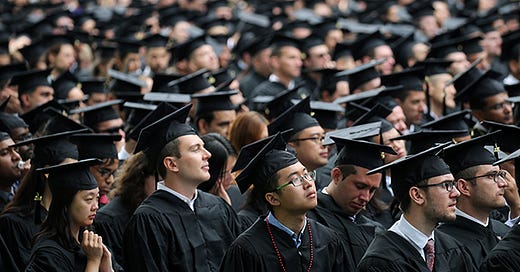There Just Aren’t Enough College-Educated Voters!
You Can Ignore the Working Class If You Like, But That Would Be Very, Very Unwise
Education polarization is increasing election on election in the United States. In 2012, the difference in Democratic support between college-educated and noncollege (working class) voters in the Presidential election was about 4 margin points (Catalist data, two party vote), with college voters being more favorable to the Democrats than noncollege voters. In 2016 that difference ballooned to 18 points. And in 2020, it went up again to 22 points.
Democrats seem remarkably relaxed about this polarization, despite liking to style themselves as the party for “working people”. One reason for this is the general perception that the college-educated population is growing while the working class is declining. True as far as it goes but the fact remains that noncollege voters far outnumber college voters. In the 2020 Catalist data, the tally was 63 percent noncollege/37 percent college. That means that any given shift among noncollege voters is significantly more consequential than a similarly-sized shift among college voters. This situation will continue for many election cycles, as the noncollege voter share is likely to decline only gradually.
Another reason for Democratic complacency is the firm belief that Democrats’ working class problem is solely confined to whites and that white working class voters are so racist/reactionary that it is a badge of honor to ignore them. This is highly questionable as a matter of political strategy and arithmetic, given that they are 44 percent of voters and a lot more than that in key swing states and districts.
But there is a deeper problem. The perception that nonwhite working class voters are a lock for the Democrats is no longer tenable. In the 2020 election, working class nonwhites moved sharply toward Trump by 12 margin points, despite Democratic messaging that focused relentlessly on Trump’s animus toward nonwhites. According to Pew, Trump actually got 41 percent of the Hispanic working class vote in 2016. Since 2012, running against Trump twice, Democrats have lost 18 points off of their margin among nonwhite working class voters.
Given this development, how did the Democrats manage to win in 2020? In broad brush terms, Democrats’ modest gains among the white working class—still by far the largest part of the working class—were about enough to cancel out the nonwhite working class losses, thereby allowing the Democrats’ white college gains to put them over the top. But if both segments of the working class move in tandem against the Democrats, that will be a big, big problem that gains among college voters—even if they continue—may not solve.
And will those gains continue? That is not clear. Liberal college graduates, especially liberal white college graduates, have gained a sort of hegemony in the nation’s elite media, foundations and NGOs, in academic and cultural institutions and in the staffing of the Democratic party’s infrastructure. This hegemony sets the tone for the Democratic party’s commitments and rhetoric on sociocultural issues.
But college graduates as a whole are not that liberal. For example, according to the 2020 exit poll, just one-quarter of white college graduates identified as liberal compared to 38 percent moderate and 37 percent conservative. It is likely that a good chunk of Democrats’ gains among this group in 2020 stemmed from distaste for Trump rather than underlying liberalism. As I have previously noted, the cultural left puts a ceiling on Democratic party support and it is possible that may apply as well to Democrats’ ability to keep growing support among college graduates.
More broadly, as Matt Yglesias noted in a recent article documenting the growth and extent of education polarization:
[H]aving society sharply polarized around occupational categories and educational attainment is going to make it very difficult for us to function effectively as a country… [S]tark education polarization is really bad for Democrats’ prospects of winning a Senate majority….[M]athematically, Democrats cannot govern in the long term without increasing their appeal to less-educated voters…..For some people, of course, the current system works great. Culture wars and skewed maps help Republicans win elections, after which they cut taxes for rich people and multinational corporations while doing nothing to satisfy their base’s resentments — resentments that fuel the fire for the next campaign.
In short, Democrats should not be complacent about education polarization. College graduates are neither numerous nor reliable enough to underpin a dominant coalition. Their party’s fate—and that of the country’s prospects for effective governance—depends on reducing this polarization as much and as rapidly as possible.




